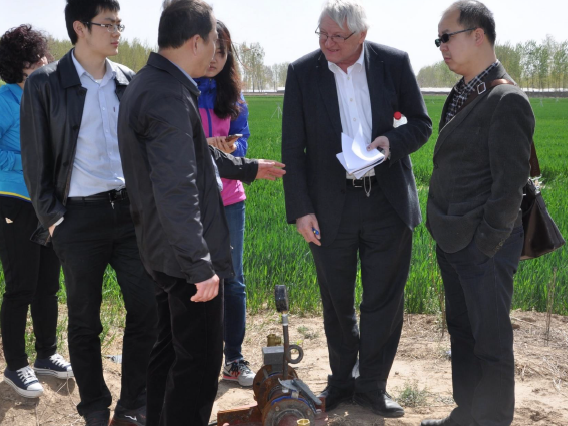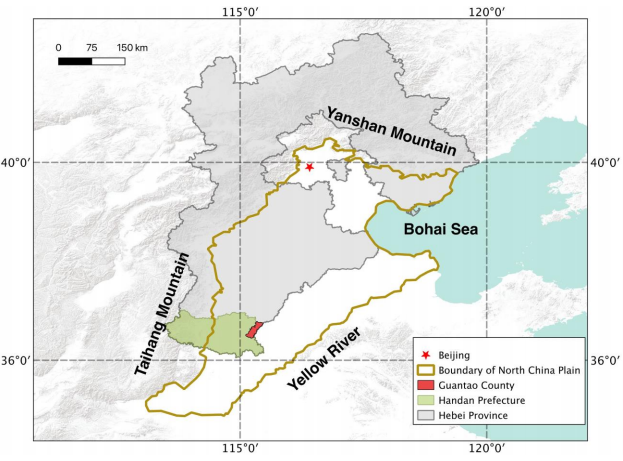Real-time groundwater monitoring and modeling system

Summary
The report* discusses the challenges of over-pumping of aquifers due to agricultural irrigation. In the North China Plain, groundwater levels dropped by about 1 m/yr since the 1980s, leading to the drying up of streams and wetlands, and making the production system more vulnerable to climatic extremes. Recognizing these challenges, the Swiss Agency for Development and Cooperation and the Ministry of Water Resources of the People’s Republic of China co-launched the project “Rehabilitation and management strategies of over-pumped aquifers in a changing climate” in 2014, in partnership with the China Geological Survey. This report features the impressive results of the second phase of the project which developed, tested and implemented an array of innovative approaches and tools for monitoring and modelling groundwater abstraction, as well for supporting sustainable management decisions.
*Download the full text from the right-hand column. Key messages from the brief are provided below. See the full text for much more detail.
In the Report
Chapter 1 introduces readers to the sustainability problem of overpumping of aquifers in the North China Plain (NCP). It describes the decrease in the well yields and the increase in energy cost of pumping which have been experienced in the NCP since the 1980s, and it shows how this was linked to the introduction of large-scale irrigation. It provides hydrological details of the groundwater system of the NCP and gives an example of a real-time groundwater management system that was set up in Guantao County.
Chapter 2 summarizes China’s recent national policy for groundwater management and assesses the efficiency of major measures for groundwater over pumping control in Hebei province. The overall governance structure of the water sector in China is described.
Chapter 3 evaluates the options in the agriculture sector to curb over-pumping in Hebei based on an analysis of planting scenarios, and analyses data from a farmer household survey. The chapter also reports findings from innovative policy test in Guantao County based on a groundwater game.
Chapter 4 discusses the technical tools available to support groundwater in management in Guantao County including monitoring options and groundwater models. It shows how the tools were integrated in a web-based decision support system with a simple user interface
Chapter 5 articulates the continued need of managing groundwater sustainably, avoiding not only over-pumping of the resource but also utilizing its buffer capacity to overcome extremes and preventing the further deterioration of its quality.
Introduction
The depletion of aquifers by excessive pumping is one of the prominent global sustainability issues in the field of water resources. It is mainly caused by the water needs of irrigated agriculture. The North China Plain is a global hotspot of groundwater overexploitation. Since the 1980s, groundwater levels dropped by about 1 m/yr due to the intensification of agricultural production by a double cropping system of winter wheat and summer maize, needed to feed a growing population. While the region has a precipitation of 500 to 600 mm/yr, rainfall mainly occurs in the monsoon season between June and September. Therefore, the winter crop heavily relies on irrigation with groundwater, as during its growth season both precipitation and surface water are scarce. The consequences of declining groundwater levels are felt throughout the region. They include the drying up of streams and wetlands, soil subsidence, seawater intrusion at the coast and rising cost of pumping. Last but not least, the depletion of storage makes the production system more vulnerable with respect to climatic extremes associated with climate change.

The ‘Rehabilitation and management strategies of over-pumped aquifers in a changing climate’ project
Recognizing the groundwater over-exploitation issue in the North China Plain, the Swiss Agency for Development and Cooperation and the Ministry of Water Resources of the People’s Republic of China co-launched the project “Rehabilitation and management strategies of over-pumped aquifers in a changing climate” in 2014, in partnership with the China Geological Survey. The leading project implementation partner on the Chinese side is the General Institute of Water Resources and Hydropower Planning Design (GIWP), and the leading project implementation partner on the Swiss side is the Swiss Federal Institute of Technology (ETH) Zurich.
The overall goal of the project is to test and implement groundwater management and water saving policies in order to strengthen the capacity for adaptation to climate variability and climate change. Any management strategy must be based on reliable data. A main element of the project is thus to establish a real time groundwater monitoring and control system. This monitoring data, coupled with state-of-the-art modelling, serves as a basis for the development and implementation of different policy instruments in the fields of water resources and agriculture.
The project worked in two pilot sites: Heihe mid reach in Gansu province and Guantao County of Handan Prefecture in the North China Plain. For the project’s second phase, this study chose Guantao County, in Handan Prefecture of Hebei Province for an in-depth analysis of a path to sustainable groundwater use.
Method and Tools
The project developed, tested and implemented an array of innovative approaches and tools for monitoring and modelling groundwater abstraction, as well for supporting sustainable management decisions. The project also reviewed and assessed various control policies, including the ones introduced in Guantao by the provincial government.
Outputs
Cutting-edge groundwater models, both real-time and data driven, were established and a web-based comprehensive decision support system (DSS) was developed.
The project also developed a groundwater game, which mimics the agricultural practice in the North China Plain and was used in a serious game approach to assess farmers’ reactions to policy changes. The game was developed alongside a farmers’ survey carried out by a research team from the China Center of Agricultural Policy of Peking University to evaluate the willingness of farmers to take part in the present winter wheat fallowing program. The game “Save the Water” was developed by the project in two stages, a board game and a computer app based on it (Fig 31.). Both were used in Guantao to test farmers’ feedback to different pumping control policies.

In the second phase of the project, one main task was the seamless integration of those tools into a unified framework to assist groundwater management in Guantao.The Guantao Decision Support System (GTDSS) aims to support:
- Monitoring: Informing decision makers about states of the system based on observation data and model estimates, where the states include groundwater level, cropping area, water use and hydro-climatic conditions, etc.
- Planning: Designing management strategies according to sustainability criteria and the target performance specified by decision makers
The GTDSS entails tools for water quota planning, scenario analysis, estimation of actual crop water demand, remote sensing based automatic mapping of cropped areas, and a data base, all integrated in one platform (Fig. 80)
Measures to reduce over-pumping
The measures adopted for over-pumping control include activities in the sectors of agriculture, forestry and water resources and can be categorized into two classes: demand side measures and supply side measures. Among the demand-side measures agriculture contributed mainly with subsidized fallowing of winter wheat, while forestry gave incentives to convert winter crops to water saving non-food crops such as trees. The water resources sector contributed by water saving irrigation technology and a water price reform system. The main activity of the water resources sector was, however, on the supply side, consisting of massive imports of surface water from the South (Yellow River and Yangtze River) to replace groundwater pumping and to increase the aquifer recharge.
In this project, policies on national, provincial, and local levels are summarized. Measures implemented in the field are assessed and effective measures are recommended for further implementation (Box 5, reproduced below)

See chapter 5 for further information on recommended measures.
Lessons Learnt
The assessment of control policies in Guantao showed that the combination of fallowing, water saving irrigation and substituting groundwater by surface water was effective in reducing aquifer depletion. The positive outcomes of the last 6 years’ management were evaluated on the basis of the water balance as well as the monitoring data. The water gap was about halved compared to the preproject period from 2000 to 2013 and is now limited to the deep aquifer. The groundwater monitoring data show the same result. Unsustainable use of the deep aquifer is prevalent in some regions. In these areas, deep wells can only be shut down if their water can be substituted by surface water or fallowing measures.
It is also important that groundwater management approaches can react to more systematic changes in the future, be it a change in crop water demand due to rising temperatures or changes in recharge due to changes in rainfall and rainfall patterns. The decision support system developed in this project can keep track and help in designing the right answers within an adaptive management approach.
The project reviewed the influence of climate change on crop water deficit, looking at scenarios for 2035 to 2064 and for 2070 to 2099. Downscaling is required to obtain a higher spatial resolution suited for the scale of the region. Some studies show likely increase in annual precipitation but at varying, while others project a decline in annual precipitation.
To conclude, we see the continued need of managing groundwater sustainably, avoiding not only over-pumping of the resource but also utilizing its buffer capacity to overcome extremes and preventing the further deterioration of its quality.
In addition to reading the full report, you may also watch the e-courses:
Webinar e-lecture series “Innovation in Groundwater Management” on YouTube in English
Webinar e-lecture series “Innovation in Groundwater Management”on Youku in Chinese.
(0) Comments
There is no content